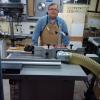I've read much on this forum but haven't seen a clear answer to what I'm looking for. My uncle owns a 36-812 type 1 Unisaw. He purchased it used, the previous owner had replaced the motor in 2005 or 2006 with a Marathon 3HP model: 145TBFR15506. Also, the saw was wired with a single pole switch and appeared to have been used this way for a while. So one leg was on a switch, the other was continuously energized. No overload protection is present on the motor or remotely located, and the switch is obviously the wrong switch.
A couple of questions. I've removed the switch and hardwired the motor for testing purposes. The motor now trips the breaker shortly after being turned on (2-5 seconds). I took the motor completely apart, and cleaned out all the sawdust. I found one spot where one of the leads from the start capacitor had shorted to the cover. I fixed this and replaced both capacitors. There does not appear to be a centrifugal switch. The only switch is one connected to the two capacitors. Everything in the motor looks fine, nothing looks or smells burned. There are no contacts to be cleaned up that I can find. I can only guess that something is wrong with this "capacitor" switch or a winding is toast. The motor still trips the breaker as before. I've checked all plug and outlet wiring and the breaker is good. Anyone have any thoughts on this? Can these capacitor switches be replaced, or are they known to anyone to be a problem? Or do you think it's most likely a winding? I have no place locally to take the motor for testing.
My other question is regarding the new switch/starter setup. In one scenario, I'm considering installing a switch like the Delta part number: 438013170154. I believe this would be okay for use with this 3hp motor and would provide the benefits of a magnetic starter as well as some overload protection. As a second scenario, I was wondering what some of you would suggest in terms of a specific magnetic starter (brand and model in your experience) and remote switch. One issue I worry about with a mag starter is the potential for it to become accidentally activated by bumping it or something dropping against it, which I've read has happened. So I'd want an extra disconnect switch wired in ahead of the starter. I was thinking the grizzly switch H8243 for the remote switch for the starter, and then maybe just a basic heavy duty 2-pole switch for the disconnect prior to the starter. What do you guys think? Thanks.




 Reply With Quote
Reply With Quote

